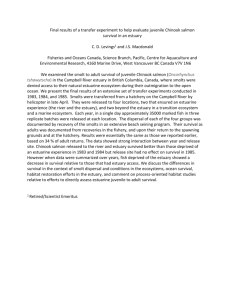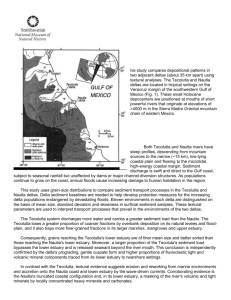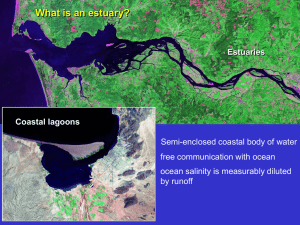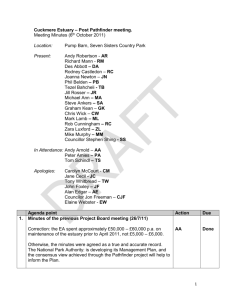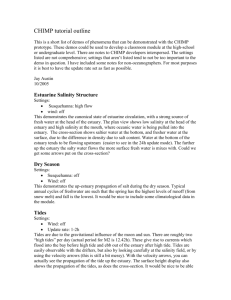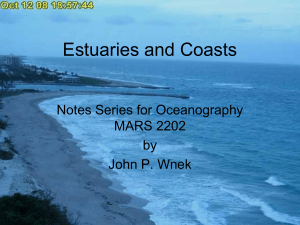abstract
advertisement
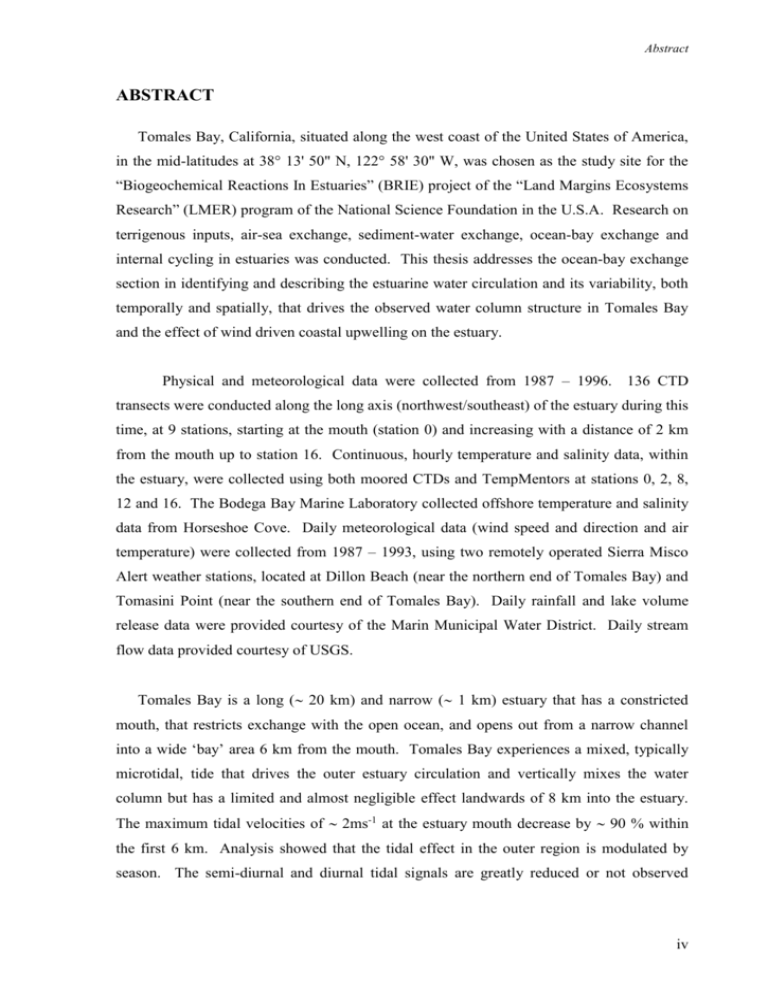
Abstract ABSTRACT Tomales Bay, California, situated along the west coast of the United States of America, in the mid-latitudes at 38° 13' 50" N, 122° 58' 30" W, was chosen as the study site for the “Biogeochemical Reactions In Estuaries” (BRIE) project of the “Land Margins Ecosystems Research” (LMER) program of the National Science Foundation in the U.S.A. Research on terrigenous inputs, air-sea exchange, sediment-water exchange, ocean-bay exchange and internal cycling in estuaries was conducted. This thesis addresses the ocean-bay exchange section in identifying and describing the estuarine water circulation and its variability, both temporally and spatially, that drives the observed water column structure in Tomales Bay and the effect of wind driven coastal upwelling on the estuary. Physical and meteorological data were collected from 1987 – 1996. 136 CTD transects were conducted along the long axis (northwest/southeast) of the estuary during this time, at 9 stations, starting at the mouth (station 0) and increasing with a distance of 2 km from the mouth up to station 16. Continuous, hourly temperature and salinity data, within the estuary, were collected using both moored CTDs and TempMentors at stations 0, 2, 8, 12 and 16. The Bodega Bay Marine Laboratory collected offshore temperature and salinity data from Horseshoe Cove. Daily meteorological data (wind speed and direction and air temperature) were collected from 1987 – 1993, using two remotely operated Sierra Misco Alert weather stations, located at Dillon Beach (near the northern end of Tomales Bay) and Tomasini Point (near the southern end of Tomales Bay). Daily rainfall and lake volume release data were provided courtesy of the Marin Municipal Water District. Daily stream flow data provided courtesy of USGS. Tomales Bay is a long ( 20 km) and narrow ( 1 km) estuary that has a constricted mouth, that restricts exchange with the open ocean, and opens out from a narrow channel into a wide ‘bay’ area 6 km from the mouth. Tomales Bay experiences a mixed, typically microtidal, tide that drives the outer estuary circulation and vertically mixes the water column but has a limited and almost negligible effect landwards of 8 km into the estuary. The maximum tidal velocities of 2ms-1 at the estuary mouth decrease by 90 % within the first 6 km. Analysis showed that the tidal effect in the outer region is modulated by season. The semi-diurnal and diurnal tidal signals are greatly reduced or not observed iv Abstract during periods of winter fresh-water flow, but increase in significance during spring and summer and dominate the observed signals during autumn. The effect of other mechanisms that drive water circulation increases with increasing distance from the mouth. Winter fresh-water inflow enters Tomales Bay from Lagunitas Creek at the head of the estuary and from Walker Creek 5 km from the mouth. Freshwater inflow is both fresher and slightly cooler than the estuarine water. As a consequence of the freshness, it flows seawards as a surface layer, stratifying the water column. The strength and persistence of the stratification depends on the intensity and duration of the fresh-water inflow. Fresh-water inflow also increases the ocean-estuary exchange and exchange between the middle and outer estuarine regions. Increased incoming solar radiation in spring and summer increases the water temperature and salinity. The increase in salinity of the water results in a decrease in the longitudinal salinity gradient and consequently density gradient. The salinity of the inner estuary reaches marine values by early summer but continues to rise throughout summer and the estuary typically becomes hypersaline in late summer / autumn. Exchange within the estuary is at a minimum during this period and flushing times (exchange between the estuary and ocean) are 3 months. With autumn cooling, maximum density conditions within the inner region occur that may lead to inverse conditions and inverse circulation may occur over short periods of time. The adjacent coastal region is dominated by wind-driven upwelling during summer. The cold, upwelled water is moved into Bodega Bay and towards Tomales Bay and enters the estuary with the tide. If the tidal excursion is 6 km and the cold water subducts beneath the warmer, less dense estuarine water, a temperature controlled density current may then form and intrude towards the head of the estuary as a thermally stratified bottom layer. The Delft3D model successfully reproduced the density current intrusions and showed that the persistence and removal of the density currents are affected by other physical parameters, to varying degrees. Increased solar heating strengthened the vertical stratification in the middle region, reducing vertical mixing and consequently strengthened the density current, indicating that intrusion events are likely to be stronger during summer. The middle and inner regions are shallow and a continuous wind speed of > 6ms -1 was observed to break down a typical density current through vertical mixing of the water v Abstract column, even though the vertical mixing was not complete. A wind speed of > 15 ms -1 was required to completely mix the water column. Winds also affect the timing of the intrusions as a density current can only develop under calm or no wind conditions. Fresh-water inflow had no impact on the density current intrusions. A decrease in depth resulted in the destruction of a typical density current due to an increase in tidal velocities. Mechanisms that result in the inhibition of density current formation are likely to be detrimental to the system as these summer intrusions are the only source of ‘new’ water that enters the estuary during the long summer residence periods. Larger scale forces, both seasonal and inter-annual, also play a role in driving the circulation within Tomales Bay. The seasonal signal is governed by the Mediterraneanclimate where an increase in solar heating causes an increase in the salinity, temperature and density of the estuary and the estuary is typically warm, with a longitudinal temperature gradient evident from the mouth to the head, salty and vertically mixed. A decrease in solar heating leads to a decrease in temperature eliminating the longitudinal temperature gradient. Increased fresh-water inflow decreases the salinity and density of the estuary, causing longitudinal salinity and density gradients to develop. The seasonal effects are more pronounced at the head of the estuary and diminished towards the mouth. Inter-annual variability is closely linked to the climate of the region. Inter-annual variability was observed in the intensity of upwelling that affects both the timing and intensity of density current intrusions, the water temperature and salinity. However, statistical analyses showed that no obvious trends in these inter-annual fluctuations were observed. Long-term impacts through anthropogenic influences may also alter the currently observed circulation patterns. The most likely impacts on the system would be the controlled release of fresh-water into the system during the dry summer periods and sediment loading, shallowing the system. Controlled dam release during the dry period could potentially decrease the flushing time of the estuary but would also alter the typical circulation of that period. The currently observed circulation would also be altered if a shallowing and shortening of the estuarine basin occurred due to sediment infilling. The potential for this, however, is small as Tomales Bay land use patterns are stable and further development is unlikely through government control of land use planning and zoning ordinances and the protection of the estuary under the Gulf of Farallones National Marine Sanctuary (USA). vi


